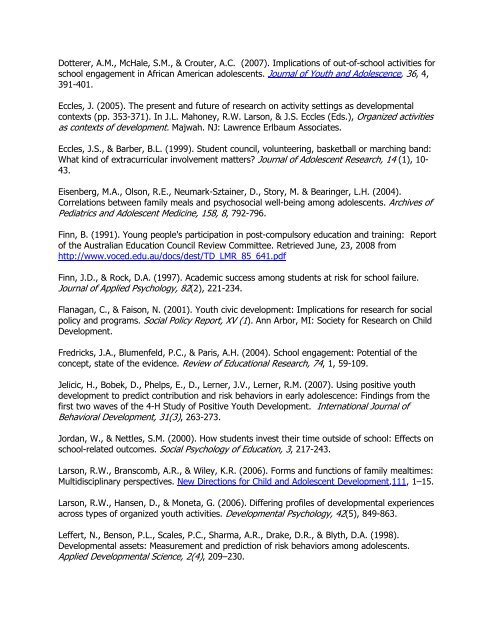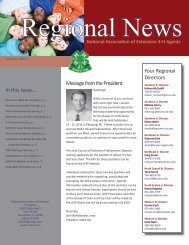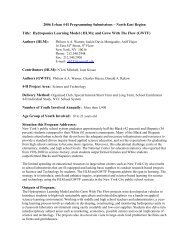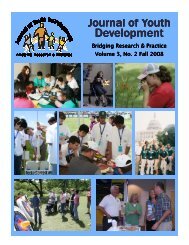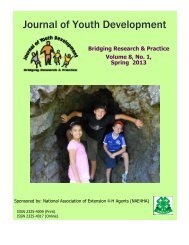Dotterer, A.M., McHale, S.M., & Crouter, A.C. (2007). Implications <strong>of</strong> out-<strong>of</strong>-school activities forschool engagement in African American adolescents. Journal <strong>of</strong> Youth and Adolescence, 36, 4,391-401.Eccles, J. (2005). The present and future <strong>of</strong> research on activity settings as developmentalcontexts (pp. 353-371). In J.L. Mahoney, R.W. Larson, & J.S. Eccles (Eds.), Organized activitiesas contexts <strong>of</strong> development. Majwah. NJ: Lawrence Erlbaum Associates.Eccles, J.S., & Barber, B.L. (1999). Student council, volunteering, basketball or marching band:What kind <strong>of</strong> extracurricular involvement matters? Journal <strong>of</strong> Adolescent Research, 14 (1), 10-43.Eisenberg, M.A., Olson, R.E., Neumark-Sztainer, D., Story, M. & Bearinger, L.H. (2004).Correlations between family meals and psychosocial well-being among adolescents. Archives <strong>of</strong>Pediatrics and Adolescent Medicine, 158, 8, 792-796.Finn, B. (1991). Young people's participation in post-compulsory education and training: Report<strong>of</strong> the Australian Education Council Review Committee. Retrieved June, 23, <strong>2008</strong> fromhttp://www.voced.edu.au/docs/dest/TD_LMR_85_641.pdfFinn, J.D., & Rock, D.A. (1997). Academic success among students at risk for school failure.Journal <strong>of</strong> Applied Psychology, 82(2), 221-234.Flanagan, C., & Faison, N. (2001). Youth civic development: Implications for research for socialpolicy and programs. Social Policy Report, XV (1). Ann Arbor, MI: Society for Research on ChildDevelopment.Fredricks, J.A., Blumenfeld, P.C., & Paris, A.H. (2004). School engagement: Potential <strong>of</strong> theconcept, state <strong>of</strong> the evidence. Review <strong>of</strong> Educational Research, 74, 1, 59-109.Jelicic, H., Bobek, D., Phelps, E., D., Lerner, J.V., Lerner, R.M. (2007). Using positive youthdevelopment to predict contribution and risk behaviors in early adolescence: Findings from thefirst two waves <strong>of</strong> the 4-H Study <strong>of</strong> Positive Youth Development. International Journal <strong>of</strong>Behavioral Development, 31(3), 263-273.Jordan, W., & Nettles, S.M. (2000). How students invest their time outside <strong>of</strong> school: Effects onschool-related outcomes. Social Psychology <strong>of</strong> Education, 3, 217-243.Larson, R.W., Branscomb, A.R., & Wiley, K.R. (2006). Forms and functions <strong>of</strong> family mealtimes:Multidisciplinary perspectives. New Directions for Child and Adolescent Development,111, 1–15.Larson, R.W., Hansen, D., & Moneta, G. (2006). Differing pr<strong>of</strong>iles <strong>of</strong> developmental experiencesacross types <strong>of</strong> organized youth activities. Developmental Psychology, 42(5), 849-863.Leffert, N., Benson, P.L., Scales, P.C., Sharma, A.R., Drake, D.R., & Blyth, D.A. (1998).Developmental assets: Measurement and prediction <strong>of</strong> risk behaviors among adolescents.Applied Developmental Science, 2(4), 209–230.
Lerner, R.M. (2007). The Good Teen: Rescuing Adolescents from the Myths <strong>of</strong> the Storm andStress Years. New York, NY: The Crown Publishing Group.Lerner R.M. (2004). Liberty: Thriving and civic engagement among American youth. ThousandOaks, CA: Sage.Lerner, R.M., Lerner, J.V., Almerigi, J., Theokas, C., Phelps, E., Gestsdottir, S., & et al. (2005).Positive youth development, participation in community youth development programs, andcommunity contributions <strong>of</strong> fifth grade adolescents: Findings from the first wave <strong>of</strong> the 4-HStudy <strong>of</strong> Positive Youth Development. Journal <strong>of</strong> Early Adolescence, 25, 17-71.Mahoney, J.L., Parente, M.E., & Zigler, E.F. (in press). After-school program participation andchildren’s development. Invited chapter to appear in J. Meece & J. S. Eccles (Eds.), Handbook<strong>of</strong> research on schools, schooling, and human development.Mahoney, J.L., Harris, A.L., & Eccles, J.S. (2006). Organized activity participation, positive youthdevelopment, and the over-scheduling hypothesis. Social Policy Report, 20 (4), 1-31.Radl<strong>of</strong>f, L.S. (1977). The CES-D scale: A self-report depression scale for research in the generalpopulation. Applied Psychological Measurement, 1, 385-401.Roth, J.L., & Brooks-Gunn, J. (2003). What exactly is a youth development program? Answersfrom research and practice. Applied Developmental Science, 7, 92-109.Sherrod, L.R. (2007). Civic engagement as an expression <strong>of</strong> positive youth development. InR.K. Silbereisen & R.M. Lerner (Eds.). Approaches to positive youth development. London: SagePublications.Theokas, C., & Lerner, R.M. (2006). Observed ecological assets in families, schools, andneighborhoods: Conceptualization, measurement and relations with positive and negativedevelopmental outcomes. Applied Developmental Science, 10(2), 61-74.Verba, S., Schlozman, K.L., & Brady, H.E. (1995). Voice and equality: Civic voluntarism inAmerican politics. Cambridge: Harvard University Press.Wong, C.A., & Rowley, S.J. (2001). The schooling <strong>of</strong> ethnic minority children: Commentary.Educational Psychologist, 36(1), 57 – 66.Zarrett, N., Fay, K., Li, Y., Carrano, J., Phelps, E., & Lerner, R. (in press). More than Child'sPlay: Variable- and Pattern-Centered Approaches for Examining the Effects <strong>of</strong> SportsParticipation on Youth Development. Developmental Psychology.Zarrett, N., & Eccles, J. (2006). The passage to adulthood: Challenges <strong>of</strong> late adolescence. Newdirections for youth development, 111, 13-28.© Copyright <strong>of</strong> Journal <strong>of</strong> Youth Development ~ Bridging Research and Practice. Content may not becopied or emailed to multiple sites or posted to a listserv without copyright holder’s express writtenpermission. However, users may print, download or email articles for individual use.
- Page 2 and 3: Winter 2008Volume 3 Number 3Editor
- Page 5: Examining the Potential Unintended
- Page 8 and 9: centered, multidisciplinary approac
- Page 10 and 11: Volume 3, Number 3, Winter 2008Arti
- Page 12 and 13: fostering skill learning and positi
- Page 14 and 15: Table 1Participation in out-of-scho
- Page 16 and 17: ResultsOur analyses were conducted
- Page 18 and 19: watching TV, playing video games or
- Page 20 and 21: Accordingly, this research augments
- Page 24 and 25: A Descriptive View of the 4-H Club
- Page 26 and 27: In this paper, the results of a cro
- Page 28 and 29: section is a set of statements that
- Page 30 and 31: Table 3Experience in the 4-H clubNo
- Page 32 and 33: significantly higher than Caucasian
- Page 34 and 35: p
- Page 36 and 37: This study focused only on the 4-H
- Page 38 and 39: Theokas, C., Lerner, J.V., Phelps,
- Page 40 and 41: Volume 3, Number 3, Winter 2008Arti
- Page 42 and 43: potential for reaching audiences, d
- Page 44 and 45: Putting Marketing Concepts into Pra
- Page 46 and 47: 2. Find out what others think about
- Page 48 and 49: Diem, K.G. (1994). What do youth li
- Page 50 and 51: Promoting Supportive Relationships
- Page 52 and 53: focused on youth-adult relationship
- Page 54 and 55: Conversely, more modern educational
- Page 56 and 57: perhaps most importantly, the effic
- Page 58 and 59: Organized youth programs, when stru
- Page 60 and 61: likely to internalize the positive
- Page 62 and 63: Ellis, J.M., & Caldwell, L.L. (2005
- Page 64 and 65: Schweinle, A., Meyer, D.K., & Turne
- Page 66 and 67: Volume 3, Number 3, Winter 2008Arti
- Page 68 and 69: This study uses the “5 Cs” mode
- Page 70 and 71: ResultsIn this analysis 48 codes we
- Page 72 and 73:
Table 3Inductive Codes Classified b
- Page 74 and 75:
CompetenceCompetence in organized s
- Page 76 and 77:
ecause of him (the coach)…. You d
- Page 78 and 79:
practices and competitions, the gir
- Page 80 and 81:
Eccles, J.S., & Gootmann, J.A. (Eds
- Page 82 and 83:
Smoll, F.L., & Smith, R.E. (2002).
- Page 84 and 85:
Volume 3, Number 3, Winter 2008Arti
- Page 86 and 87:
The present work builds upon that o
- Page 88 and 89:
MethodSample and Data CollectionAs
- Page 90 and 91:
(scores ranging from 0 to 8) and a
- Page 92 and 93:
Table 2Paired Sample T-tests Compar
- Page 94 and 95:
Hypotheses 5 and 6 were tested by c
- Page 96 and 97:
De Coverly Veale, D.M.W. (1987). Ex
- Page 98 and 99:
Story, M., Neumark-Sztainer, D., Sh
- Page 100 and 101:
Volume 3, Number 3, Winter 2008Arti
- Page 102 and 103:
Cronbach’s Alpha Score For Youth
- Page 104 and 105:
12 to 18 years old. Fourteen of the
- Page 106 and 107:
Therefore, there was a mixed relati
- Page 108 and 109:
Youth respondents identified two ob
- Page 110 and 111:
are developed through working in a
- Page 112 and 113:
Seevers, B.S., & Dormody, T.J. (199
- Page 114 and 115:
Volume 3, Number 3, Winter 2008Arti
- Page 116 and 117:
With the many opportunities that yo
- Page 118 and 119:
meaningfully reduced involving dedu
- Page 120 and 121:
StaffingXTime/Schedule X X XTrainin
- Page 122 and 123:
“Involving adults that will allow
- Page 124 and 125:
“They can't drive or do not have
- Page 126 and 127:
page in understanding why youth voi
- Page 128 and 129:
Parker, L. (1999). If all youth ser
- Page 130 and 131:
Volume 3, Number 3, Winter 2008Arti
- Page 132 and 133:
However, the literature is mixed in
- Page 134 and 135:
group was the quality of the progra
- Page 136 and 137:
Table 1Reasons for Non-Attendance:
- Page 138 and 139:
easons given was six. Sixty-three p
- Page 140 and 141:
The non-family-related activities t
- Page 142 and 143:
“Catch ‘Em Being Good:”An Ext
- Page 144 and 145:
In 2001, the WVUES received a schoo
- Page 146 and 147:
to leverage the resources of the co
- Page 148 and 149:
4. Most primary behavior incidents
- Page 150 and 151:
Recommendations for developing prog
- Page 152 and 153:
Cross-Cultural UnderstandingThrough
- Page 154 and 155:
that plague these nations such as p
- Page 156 and 157:
2003). Youth leadership training in
- Page 158 and 159:
• enable these young people to pa
- Page 160 and 161:
We believe that the USPORT program
- Page 162 and 163:
West Virginia’s Response to theRo
- Page 164 and 165:
Ensuring good oral health requires
- Page 166 and 167:
Table 1Correlations between Planner
- Page 168 and 169:
problems in this rural state…This
- Page 170 and 171:
Volume 3, Number 3, Winter 2008Arti
- Page 172 and 173:
vacuum. Determination of factors, a
- Page 174 and 175:
ReferencesBaldwin, C., & Caldwell,
- Page 176 and 177:
Volume 3, Number 3, Winter 2008Arti
- Page 178 and 179:
Purpose of StudyThe purpose of this
- Page 180 and 181:
Students in the High computer gamin
- Page 182 and 183:
Do Higher Levels of 4-H LeadershipA
- Page 184 and 185:
IntroductionEmotional Intelligence
- Page 186 and 187:
second section examined demographic
- Page 188 and 189:
a constructive manner. The group is
- Page 190 and 191:
differences in the scores for the 1
- Page 192 and 193:
Adaptability include “Reality Tes
- Page 194 and 195:
ReferencesAmerican Academy of Pedia
- Page 196 and 197:
Healthy Kids, Healthy Families:A Co
- Page 198 and 199:
and a half million U.S. youth (ages
- Page 200 and 201:
Families. In partnering counties, p
- Page 202 and 203:
Healthy Families was then offered a
- Page 204 and 205:
Kamberelis, G., & Dimitriadis, G. (
- Page 206 and 207:
Volume 3, Number 3, Winter 2008Arti
- Page 208 and 209:
Change It Up!What Girls Say About R
- Page 210:
In addition, the study summarizes t


